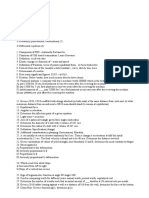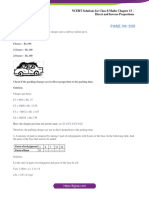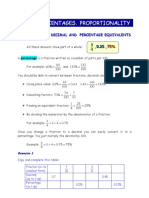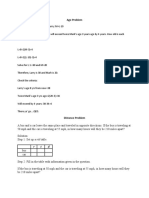SAT 2016 The SAT Math Test: Problem Solving and Data Analysis
SAT 2016 The SAT Math Test: Problem Solving and Data Analysis
Uploaded by
Elen KarapetyanCopyright:
Available Formats
SAT 2016 The SAT Math Test: Problem Solving and Data Analysis
SAT 2016 The SAT Math Test: Problem Solving and Data Analysis
Uploaded by
Elen KarapetyanOriginal Description:
Original Title
Copyright
Available Formats
Share this document
Did you find this document useful?
Is this content inappropriate?
Copyright:
Available Formats
SAT 2016 The SAT Math Test: Problem Solving and Data Analysis
SAT 2016 The SAT Math Test: Problem Solving and Data Analysis
Uploaded by
Elen KarapetyanCopyright:
Available Formats
Main page
PDf library
AP exam
SAT exam
Test Prep
Biology
Chemistry
Geography
Economics
Language
Literature
Mathematics
Pedagogy
Physics
Science
Social science
Statistics
Summary & Essay
Computer science
History
Feedback
Nonfiction
SAT 2016
CHAPTER 8
The SAT Math Test:
Problem Solving and Data
Analysis
Skill 2: Working with Rates,
Ratios, Percentages, and
Proportions
Lesson 5: Rates and unit rates
On a sunny day, a 50 square
meter section of solar panel array
can generate an average of 1
kilowatt-hour of energy per hour
over a 10-hour period. If an
average household consumes 30
kilowatt-hours of energy per day,
how large an array would be
required to power 1,000
households on sunny days?
A) 1,500 square meters
B) 15,000 square meters
C) 150,000 square meters
D) 15,000,000 square meters
(Medium) This is clearly a “rate
problem,” because it includes two
“per” quantities. When working
with rates, keep two important
ideas in mind:
The units for any rate can be
translated to give the formula
for the rate. For instance, if a
word problem includes the fact
that “a rocket burns fuel at a rate
of 15 kilograms per second,” this
fact can be translated into a
formula as long as we remember
that per means divided by:
Any “rate fact” in a problem can
be interpreted as a “conversion
factor.” For instance, if “a rocket
burns fuel at a rate of 15 kilograms
per second,” then in the context of
that problem, one second of
burning is equivalent to 15
kilograms of fuel being burned.
Therefore, as we discussed in
Chapter 7, Lesson 4, we are
entitled to use either of the
following conversion factors in
this problem:
Ad
Mexican salad with couscous
Bonduelle Open
Just as we did in Chapter 7,
Lesson 4, we can solve this
problem by just noticing that it is
essentially a conversion
problem. The question asks “how
large an array (in square meters)
would be required to power 1,000
households on sunny days?” So
we can treat the problem as a
conversion from a particular
number of households to a
particular number of square
meters of solar panels:
Note very carefully how (1) all of
the units on the left side of the
equation cancel except for “square
meters” (which is what we want),
and (2) each conversion factor
represents an explicit fact
mentioned in the problem.
Many rate problems can be easily
managed with the “rate pie”:
This is a simple graphical device
to organize information in a rate
problem. It is simply a way of
expressing all three forms of the
“rate equation” at once: distance =
rate × time; rate = distance/time;
and time = distance/rate. For
example, if a word problem states
that “Maria completes an x-mile
bicycle race at an average speed
of z miles per hour,” your “rate pie”
should look like this:
First, we plug the given values in:
x miles goes in for distance, and z
miles per hour goes in for rate.
Then, as soon as two of the
spaces are filled, we simply
perform the operation between
them (in this case division) and
put the result in the final space.
In this case, the time Maria took to
complete the race was
x/z hours.
A water pump for a dredging
project can remove 180 gallons of
water per minute, but can work
only for 3 consecutive hours, at
which time it requires 20 minutes
of maintenance before it can be
brought back online. While it is
offline, a smaller pump is used in
its place, which can pump 80
gallons per minute. Using this
system, what is the least amount
of time it would take to pump
35,800 gallons of water?
A) 3 hour 10 minutes
B) 3 hours 15 minutes
C) 3 hours 25 minutes
D) 3 hours 30 minutes
(Hard) If we want to pump out the
water as quickly as possible, we
want to use the stronger pump for
the maximum three hours. To find
the total amount of water pumped
in that time, we do the conversion:
So after 3 hours, there are still
35,800 − 32,400 = 3,400 gallons
left to pump. At that point, the
smaller pump must be used for a
minimum of 20 minutes, which can
pump
Ad
Mexican salad with couscous
Bonduelle Open
which still leaves 3,400 − 1,600 =
1,800 gallons left. Notice that we
have already taken 3 hours and 20
minutes, and as yet have not
finished pumping. This means that
choices (A) and (B) are certainly
incorrect. So how long will it take
to pump the remaining 1,800
gallons? Now that we can bring
the stronger pump online, it will
only take 1,800 gallons × (1
minute/180 gallons) = 10 more
minutes; therefore, the correct
answer is (D).
Although you don”t need to
construct a graph of this situation
to solve the problem, graphing
helps show the overall picture:
Notice that the line has a slope of
180 for the first 180 minutes, then
80 for the next 20 minutes, and
then 180 for the next 180 minutes,
and crosses the line
y = 35,800 at 210 minutes.
In the graph of any linear function,
y in terms of x, the slope of the
line is equivalent to the unit rate
of the function, that is, the rate at
which y increases or decreases
for every unit increase in x.
Lesson 6: Ratios: part-to-part
and part-to-whole
A marathon offers $5,000 in prize
money to the top three finishers. If
the first-, second-, and third-place
prizes are distributed in a ratio of
5:4:1, how much money, in dollars,
does the second-place finisher
receive?
(Easy) When given a “part-to-part”
ratio, such as 5:4:1 (which is of
course, really a part-to-part-to-part
ratio), it often helps to add up the
parts and consider the whole. This
prize is divided into 5 + 4 + 1 = 10
equal parts, so the winner gets
5/10 of the prize money, the
second-place finisher gets 4/10 of
the prize money, and the third-
place finisher gets 1/10 of the
prize money. The second-place
finisher therefore takes home
(4/10) × $5,000 = $2,000.
If you are given a part-to-part ratio,
it is often helpful to add up the
parts and then divide each part by
the sum. For instance, if a paint
mixture is a 2:5 combination of red
and yellow, respectively, the “
whole” is 2 + 5 = 7, which means
that the mixture is 2/7 red and 5/7
yellow.
Alibaba.com O!cial Website
Alibaba.com
new model racing motorcycle
$28,320 Visit Site
Bronze is an alloy (a metallic
mixture) consisting of copper and
tin. If 50 kg of a bronze alloy of
20% tin and 80% copper is mixed
with 70 kg of a bronze alloy of 5%
tin and 95% copper, what fraction,
by weight, of the combined bronze
alloy is tin?
A) 5/48
B) 9/80
C) 1/8
D) 1/4
(Medium) The combined alloy will
weigh 50 kg + 70 kg = 120 kg. The
total weight of the tin comes from
the two separate alloys: (0.20)(50)
+ (0.05)(70) = 10 + 3.5 = 13.5 kg.
Therefore the fraction of the
combined alloy that is tin is
13.5/120, which simplifies to 9/80.
Exercise Set 2 (Calculator)
If a train travels at a constant rate
of 50 miles per hour, how many
minutes will it take to travel 90
miles?
Two cars leave the same point
simultaneously, going in the same
direction along a straight, flat road,
one at 35 miles per hour and the
other at 50 miles per hour. After
how many minutes will the cars be
5 miles apart?
If a $6,000 contribution is divided
among charities A, B, and C in a
ratio of 8:5:2, respectively, how
much more, in dollars, does
charity A receive than charity C?
If a car traveling at 60 mph is
chasing a car travelling at 50 mph
and is ¼ mile behind, how many
minutes will it take the first car to
catch the second?
A truck”s gas tank can hold 18
gallons. If the tank is 2/3 full and
the truck travels for 4 hours at 60
miles per hour until it runs out of
gas, what is the efficiency of the
truck, in miles per gallon?
A motorcycle has a fuel efficiency
of 60 miles per gallon when it is
cruising at a speed of 50 miles per
hour. How many hours can it travel
at 50 miles per hour on a full tank
of gas, if its tank can hold 10
gallons?
If the ratio of a to b is 3 to 4, and
the ratio of a to c is 5 to 2, what is
the ratio of b to c?
A) 3 to 10
B) 3 to 5
C) 5 to 3
D) 10 to 3
A paint mixture consists of a
3:2:11 ratio of red, violet, and
white, respectively. How many
ounces of violet are needed to
make 256 ounces of this mixture?
A) 32
B) 36
C) 46
D) 48
A pool that holds 20,000 gallons is
¼ full. A pump can deliver
g gallons of water every m
minutes. If the pumping company
charges d dollars per minute, how
much will it cost, in dollars, to fill
the pool?
A)
B)
You might also like
- Pre ATPL Maths and Physics Revision Course-1Document23 pagesPre ATPL Maths and Physics Revision Course-1filzovoc91% (11)
- English For Engineering Teacher's BookDocument128 pagesEnglish For Engineering Teacher's BookTomcio Dymczyk82% (34)
- Materials & Environment Solutions Manual PDFDocument71 pagesMaterials & Environment Solutions Manual PDFpankaj behera.No ratings yet
- Ebook Calculus Concepts An Informal Approach To The Mathematics of Change 5Th Edition Latorre Test Bank Full Chapter PDFDocument60 pagesEbook Calculus Concepts An Informal Approach To The Mathematics of Change 5Th Edition Latorre Test Bank Full Chapter PDFMarcusKingbicy100% (17)
- Exam Finland 2010 - 1Document6 pagesExam Finland 2010 - 1Aravind SomasundaramNo ratings yet
- Lesson 1 - Functions As ModelsDocument5 pagesLesson 1 - Functions As ModelsReylaine Mitz BaldonNo ratings yet
- O Level Biology Practice Questions And Answers EnzymesFrom EverandO Level Biology Practice Questions And Answers EnzymesRating: 5 out of 5 stars5/5 (1)
- Assignment 1 SolutionDocument5 pagesAssignment 1 SolutionAhmed AttallaNo ratings yet
- Top Ratio and Proportion Questions For Bank SSC Railway LIC ExamsDocument24 pagesTop Ratio and Proportion Questions For Bank SSC Railway LIC ExamscnkrbtncdxobNo ratings yet
- Pure Math 30 - Logarithms Lesson 4 PDFDocument11 pagesPure Math 30 - Logarithms Lesson 4 PDFHanna Grace HonradeNo ratings yet
- QuestionsDocument45 pagesQuestionsSaurav KumarNo ratings yet
- Nasa Launch Document Final1Document26 pagesNasa Launch Document Final1api-237173425No ratings yet
- RATIODocument40 pagesRATIOtrixie eustaquio100% (1)
- Math SortedDocument8 pagesMath SortedChayl Jhuren LopezNo ratings yet
- Sample Test Items Rev 08-07-19Document15 pagesSample Test Items Rev 08-07-19KomishinNo ratings yet
- NCERT Solutions For Class 8 Maths Chapter 13 Direct and Inverse ProportionsDocument14 pagesNCERT Solutions For Class 8 Maths Chapter 13 Direct and Inverse ProportionsTarunNo ratings yet
- Unit 8 Ratio and Proportion 1st LevelDocument22 pagesUnit 8 Ratio and Proportion 1st LevelyonesNo ratings yet
- د - سفيان فاضل -مبادئ هندسة كيمياوية1-مرحلة اولىDocument74 pagesد - سفيان فاضل -مبادئ هندسة كيمياوية1-مرحلة اولىAbdla DoskiNo ratings yet
- Gen Math Q1 Lesson 1Document31 pagesGen Math Q1 Lesson 1APHRO DITENo ratings yet
- Exercise 13.1 Page No: 208: NCERT Solution For Class 8 Maths Chapter 13 Direct and Inverse ProportionsDocument17 pagesExercise 13.1 Page No: 208: NCERT Solution For Class 8 Maths Chapter 13 Direct and Inverse ProportionsDanish XainNo ratings yet
- Directions: This Material Is Confidential Until The End of April 1999Document7 pagesDirections: This Material Is Confidential Until The End of April 1999Epic WinNo ratings yet
- Lesson 1Document39 pagesLesson 1calee0677No ratings yet
- Math SeriesDocument15 pagesMath SeriesRomnick VictoriaNo ratings yet
- PA1 Physics SolutionDocument5 pagesPA1 Physics Solutionkushal.gokhale123No ratings yet
- Infotech PapersDocument12 pagesInfotech PapersNeelu TiruvayipatiNo ratings yet
- Sri Sri Academy: IIT Ramaiah Entrance Test Papers - SAT - 2010Document6 pagesSri Sri Academy: IIT Ramaiah Entrance Test Papers - SAT - 2010chantaiahNo ratings yet
- Aptitude TestDocument40 pagesAptitude TestAmrut Sanglikar100% (1)
- College Algebra (Worded Problem)Document7 pagesCollege Algebra (Worded Problem)Wilmar Angelo0% (1)
- Introduction To Mathematical ModellingDocument18 pagesIntroduction To Mathematical ModellingVIGNESH L RNo ratings yet
- Full Model Test 3 - 240908 - 214438Document13 pagesFull Model Test 3 - 240908 - 214438MEHEDUL ISLAMNo ratings yet
- f4 Mat Midterm 2 ExamsDocument31 pagesf4 Mat Midterm 2 Examshashiim100% (1)
- Compass Practice TestDocument55 pagesCompass Practice Testldrutter100% (1)
- Unit8 Percentages ProportionalityDocument11 pagesUnit8 Percentages Proportionalitygiggia02No ratings yet
- Grade 8 Mths For JoshuaDocument20 pagesGrade 8 Mths For JoshuaAlan Winston SedzeNo ratings yet
- 06 2Document5 pages06 2Iam hackerNo ratings yet
- TelegramDocument20 pagesTelegramMy NotesNo ratings yet
- Mathematics B PDFDocument3 pagesMathematics B PDFSamiha IslamNo ratings yet
- Water Jugs by DiophantDocument10 pagesWater Jugs by DiophantGiánglong Thậpbát ChưởngNo ratings yet
- AMC 10 Contest A: Solutions PamphletDocument9 pagesAMC 10 Contest A: Solutions PamphletSamuel TandryNo ratings yet
- © Ncert Not To Be Republished: Ratio and ProportionDocument16 pages© Ncert Not To Be Republished: Ratio and Proportionkritagyasharma29No ratings yet
- Kinematics and Dynamics WorksheetsDocument49 pagesKinematics and Dynamics Worksheetsknoxphysics100% (1)
- GMAT Common Word ProblemsDocument8 pagesGMAT Common Word ProblemsdecentyNo ratings yet
- QA Practice Test 2Document6 pagesQA Practice Test 2GunjanNo ratings yet
- Units and Problem SolvingDocument6 pagesUnits and Problem SolvingAshturon GreesladeNo ratings yet
- GMAT Prep ProblemsDocument45 pagesGMAT Prep ProblemsAli BhattiNo ratings yet
- Quadratic Equations and Simultaneous Linear Equations ExercisesDocument7 pagesQuadratic Equations and Simultaneous Linear Equations ExercisesBenjamin BrownNo ratings yet
- 123 - Exam 2 - Fall 2010 - Actual ExamDocument12 pages123 - Exam 2 - Fall 2010 - Actual ExamJoshua BunnellNo ratings yet
- Previous Year Aptitude Questions From Various CompaniesDocument27 pagesPrevious Year Aptitude Questions From Various Companies17 CSE Lokesh VNo ratings yet
- Age ProblemDocument6 pagesAge ProblemJ'heir RavierNo ratings yet
- Sample MathDocument14 pagesSample MathprykNo ratings yet
- How to Prepare for AMC10: Problem Solving and SkillFrom EverandHow to Prepare for AMC10: Problem Solving and SkillRating: 5 out of 5 stars5/5 (1)
- Advanced Numerical Methods with Matlab 2: Resolution of Nonlinear, Differential and Partial Differential EquationsFrom EverandAdvanced Numerical Methods with Matlab 2: Resolution of Nonlinear, Differential and Partial Differential EquationsNo ratings yet
- O level Physics Questions And Answer Practice Papers 3From EverandO level Physics Questions And Answer Practice Papers 3Rating: 3 out of 5 stars3/5 (1)
- Dive Into Algorithms: A Pythonic Adventure for the Intrepid BeginnerFrom EverandDive Into Algorithms: A Pythonic Adventure for the Intrepid BeginnerNo ratings yet
- SSC CGL Preparatory Guide -Mathematics (Part 2)From EverandSSC CGL Preparatory Guide -Mathematics (Part 2)Rating: 4 out of 5 stars4/5 (1)
- TIN InformationDocument14 pagesTIN InformationAin FarhanNo ratings yet
- Study of The Mechanical and Thermal Properties of Sn-5Sb (DR Alla Bahgat)Document15 pagesStudy of The Mechanical and Thermal Properties of Sn-5Sb (DR Alla Bahgat)eidelsayedNo ratings yet
- Unit 9 - Metals and Their Compounds Student VersionDocument23 pagesUnit 9 - Metals and Their Compounds Student VersionMalike ShamelNo ratings yet
- Copper AlloysDocument61 pagesCopper Alloysbvalinhas100% (2)
- Gear Lecturers2 - 10Document17 pagesGear Lecturers2 - 10Muhammad WaqasNo ratings yet
- Chapter 8Document3 pagesChapter 8anon-785740No ratings yet
- Metals XRD PatternsDocument11 pagesMetals XRD PatternscirconaNo ratings yet
- Metal Properties, Characteristics, Uses, and Codes: Subcourse Edition OD1643 7Document97 pagesMetal Properties, Characteristics, Uses, and Codes: Subcourse Edition OD1643 7Albert ArominNo ratings yet
- Yamaha Rx-V659 (ET)Document121 pagesYamaha Rx-V659 (ET)jjcadena2000No ratings yet
- Metals and Non MetalsDocument10 pagesMetals and Non MetalsKaran MahajanNo ratings yet
- History of ChemistryDocument4 pagesHistory of ChemistryMhelshy VillanuevaNo ratings yet
- Challenges and Strategies Toward Long-Term Stability of Lead-Free Tin-Based Perovskite Solar CellsDocument14 pagesChallenges and Strategies Toward Long-Term Stability of Lead-Free Tin-Based Perovskite Solar Cellsamal shokryNo ratings yet
- Types of PCB and Wave SolderingDocument4 pagesTypes of PCB and Wave Solderingpuranamravinder100% (2)
- United States Patent Office: Benzylideneacetone-CH-CH CH-CO-CH3Document4 pagesUnited States Patent Office: Benzylideneacetone-CH-CH CH-CO-CH3danyNo ratings yet
- Material Product Data Sheet Tin and Tin Alloy (Babbit) Thermal Spray WiresDocument3 pagesMaterial Product Data Sheet Tin and Tin Alloy (Babbit) Thermal Spray WiresKhalid M. HafezNo ratings yet
- Group IV ElementsDocument11 pagesGroup IV ElementsVince MarsNo ratings yet
- Group Ivb ElementsDocument27 pagesGroup Ivb ElementsYaboi MattNo ratings yet
- Manual Yamaha YST-SW012 (Service)Document16 pagesManual Yamaha YST-SW012 (Service)Alex NikitinNo ratings yet
- General Values For ChemicalsDocument9 pagesGeneral Values For ChemicalsAakash SharmaNo ratings yet
- Naming Ionic Compounds Practice Worksheet - SolutionsDocument3 pagesNaming Ionic Compounds Practice Worksheet - SolutionsJa Son Tonogbanua100% (1)
- Chemistry Class 10 - Metals and Non-MetalsDocument11 pagesChemistry Class 10 - Metals and Non-MetalsAryanNo ratings yet
- EURONORM 145 - 78 - Tinplate and Blackplate in Sheet Form Qualities, Dimensions and Tolerances PDFDocument16 pagesEURONORM 145 - 78 - Tinplate and Blackplate in Sheet Form Qualities, Dimensions and Tolerances PDFJaveed A. KhanNo ratings yet
- Industrial Ttaining ReportDocument41 pagesIndustrial Ttaining ReportRajat Rastogi 143No ratings yet
- Review of Organotin Compounds - Chemistry and ApplicationDocument9 pagesReview of Organotin Compounds - Chemistry and ApplicationIjrei JournalNo ratings yet
- A Review of Cassiterite Beneficiation PraticesDocument23 pagesA Review of Cassiterite Beneficiation PraticesLevent ErgunNo ratings yet
- Ratio and Proportion BCSDocument10 pagesRatio and Proportion BCSB. M. SHOFIQUL ISLAM100% (1)
- Refined Lead: Standard Specification ForDocument4 pagesRefined Lead: Standard Specification Foranurag yadavNo ratings yet
- Tin Additive ElectroplatingDocument7 pagesTin Additive ElectroplatingIvan Ignacio Montecino Bacigalupo100% (1)

























































































